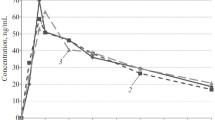Summary
Dihydroergotamine (DHE) and 5 of its main metabolites, namely 8′-hydroxy-dihydroergotamine (8′-OH-DHE), 8′,10′-dihydroxy-dihydroergotamine (8′,10′-OH-DHE), 2,3seco,N(1)formyl,3-keto,8′-hydroxy-dihydroergotamine (8′-OH,N(1)formyl-DHE), dihydrolysergic acid amide (DH-LSA) and dihydrolysergic acid (DH-LS) were investigated on human and canine veins in vitro, on canine veins in situ, and in the ganglion-blocked rat in vivo. Like DHE, the metabolites 8′-OH-DHE, 8′,10′-OH-DHE and DH-LSA caused contriction of human varicose veins and only weak α-adrenoceptor blockade. On canine femoral vein strips the same compounds produced predominantly α-adrenoceptor blockade and only negligible stimulation. 8′-OH,N(1)formyl-DHE and DH-LS were largely inactive. The same compounds, which were agonists on human vein strips in vitro, induced dose-dependent reduction of venous compliance when infused locally into the dog saphenous vein in situ. In the ganglion-blocked rat, only 8′-OH-DHE and 8′,10′-OH-DHE besides the parent drug produced an increase in diastolic blood pressure when injected intravenously. It is concluded that DHE metabolites with considerable venoconstrictor activity may contribute to the selective therapeutic action of DHE.
Similar content being viewed by others
References
Aellig WH (1974) Venoconstrictor effect of dihydroergotamine in superficial hand veins. Eur J Clin Pharmacol 7: 137–139
Aellig WH (1976) Influence of ergot compounds on compliance of superficial hand veins in man. Postgrad Med J (Suppl) 52: 21–23
Aellig WH (1981) A new technique for recording compliance of human hand veins. Br J clin Pharmacol 11: 237–243
Aellig WH, Berde B (1969) Studies of the effect of natural and synthetic polypeptide type ergot compounds on a peripheral vascular bed. Br J Pharmacol 36: 561–570
Aellig WH, Nüesch E (1977) Comparative pharmacokinetic investigations with tritium-labeled ergot alkaloids after oral and intravenous administration in man. Int J Clin Pharmacol 15: 106–112
Bluntschli HJ, Goetz RH (1948) The effect of ergot derivatives on the circulation in man with special reference to two new dihydrogenated compounds (dihydroergotamine and dihydroergocornine). Am Heart J 35: 873–894
Bobik A, Skews H, Jennings G, Esler M, Korner PI (1980) Dihydroergotamine kinetics in patients with orthostatic hypotension. Clin Exp Pharmacol Physiol 7: 648
Bobik A, Jennings G, Skews H, Esler M, McLean A (1981) Low bioavailability of dihydroergotamine and first pass extraction in patients with orthostatic hypotension. Clin Pharmacol Ther 30: 673–679
Delius L, Hammerschmidt D, Odenthal F (1949) Klinisch-experimentelle Untersuchungen über die kreislaufdynamischen Wirkungen der dihydrierten Mutterkornalkaloide. Klin Wochenschr 27: 33–34
Glusa E, Markwardt F (1982) Dual effect of dihydroergotamine and dihydroergotoxin in isolated human femoral veins and arteries. Pharmacology 24: 287–293
Hammerschmidt D, Odenthal F (1950) Über die Wirkung der hydrierten Mutterkornalkaloide auf den arteriellen und venösen Blutdruck. Z Kreislaufforsch 39: 150–160
Hilke H, Kanto J, Kleimola T, Mäntylä R (1978a) Intramuscular absorption of dihydroergotamine in man. Int J Clin Pharmacol 16: 277–278
Hilke H, Kanto J, Mäntylä R, Kleimola T, Syvälahti E (1978b) Dihydroergotamine: pharmacokinetics and usefulness in spinal anaesthesia. Acta Anaesthesiol Scand 22: 215–220
Jansen W, Enghofer E, Seibel K (1983) Einmalige Gabe von Dihydroergotamin pro Tag ausreichend? Münch Med Wochenschr 125: 498–502
Jennings G, Esler M, Holmes R (1979) Treatment of orthostatic hypotension with dihydroergotamine. Br Med J 2: 307
Kanto J (1983) Clinical pharmacokinetics of ergotamine, dihydroergotamine, ergotoxine, bromocriptine, methysergide and lergotrile. Int J Clin Pharmacol Ther Toxicol 21: 135–142
Kanto J, Allonen H, Koski K, Koulu M, Lammintausta R, Mäntylä R, Kleimola T, Siirtola T (1981) Pharmacokinetics of dihydroergotamine in healthy volunteers and in neurological patients after a single intravenous injection. Int J Clin Pharmacol Ther Toxicol 19: 127–130
Lange L, Echt M (1972) Vergleichende Untersuchungen über venentonisierende Pharmaka. Fortschr Med 90: 1161–1164
Little PJ, Jennings GL, Skews H, Bobik A (1982) Bioavailability of dihydroergotamine in man. Br J Clin Pharmacol 13: 785–790
Maurer G, Frick W (1984) Structure elucidation and receptor binding studies of the primary and major metabolites of dihydroergotamine in man. Eur J Clin Pharmacol 26: 463–470
Mellander S (1971) Effects of selected vasoactive agents on resistance, exchange and capacitance vessels in skeletal muscle. In: Bevan JA et al. (eds) Proc Symp Physiol Pharmacol Vasc. Neuroeffector Systems, Interlaken 1969. Karger, Basel, pp 333–343
Mellander S, Nordenfelt I (1970) Comparative effects of dihydroergotamine and noradrenaline on resistance, exchange and capacitance functions in the peripheral circulation. Clin Sci 39: 183–201
Müller-Schweinitzer E (1974) Studies on the peripheral mode of action of dihydroergotamine in human and canine veins. Eur J Pharmacol 27: 231–237
Müller-Schweinitzer E, Rosenthaler J (1983) Ex vivo studies after oral treatment of the beagle with dihydroergotamine. Eur J Pharmacol 89: 1–8
Olver IN, Jennings GL, Bobik A, Esler M (1980) Low bioavailability as a cause of apparent failure of dihydroergotamine in orthostatic hypotension. Br Med J 2: 275–276
Schran HF, Schwartz HJ, Talbot KC, Loeffler LJ (1979) Specific radioimmunoassay of ergot peptide alkaloids in plasma. Clin Chem 25: 1928–1933
Thulesius O, Gjöres JE, Berlin E (1979) Vasoconstrictor effect of midodrine, ST 1059, noradrenaline, etilefrine and dihydroergotamine on isolated human veins. Eur J Clin Pharmacol 16: 423–424
Ulrich J, Siggaard-Andersen J (1971) Vascular effects of dihydrogenated ergot alkaloids. Comparative effects of dihydroergostine and dihydroergotamine on the blood flow and the capacitance vessels in the human calf studied by plethysmography. Angiology 22: 622–628
Ulrich J, Jessen B, Siggaard-Andersen J (1973) Comparative effects of dihydroergotamine and Hydergine on the blood flow, capillary filtration rate and the capacitance vessels in the human calf studied by plethysmography. Angiology 24: 657–663
Author information
Authors and Affiliations
Rights and permissions
About this article
Cite this article
Müller-Schweinitzer, E. Pharmacological actions of the main metabolites of dihydroergotamine. Eur J Clin Pharmacol 26, 699–705 (1984). https://doi.org/10.1007/BF00541928
Received:
Revised:
Issue Date:
DOI: https://doi.org/10.1007/BF00541928




